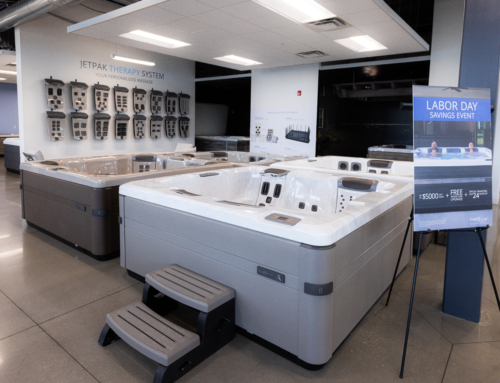What are perceptions and why do we want to challenge them? A perception is a belief or opinion based on how things seem; it’s the way someone thinks or feels about something. Perceptions are not always accurate which is why we must sometimes challenge them. This is especially true when it comes to retail buying and selling.
These days most customers who walk into your spa store have already done some level of online research leaving them with the perception that they know all they need to know about purchasing a spa. While they may have gleaned some knowledge from their research, it is usually a mere overview of brands, prices, and basic functionality of the product. As a salesperson, it’s your job to recognize common customer perceptions and misperceptions, then challenge them through selling that educates.
Understanding Customer Perception
Why is it important to manage customer perception? Probably the most compelling reason is a 2017 survey by McCann’s Truth Central which reports “42% of Americans find brands less truthful today than they did 20 years ago.” People do not buy from businesses or people they do not trust.
When a customer’s perceptions get in the way of informed buying decisions, a little education goes a long way toward producing a satisfied customer. For instance, customers trying to justify paying more for a quality spa would benefit from knowing that cheaper spas have an average lifespan of 3-5 years. Quality spas, on the other hand, last from 10-15 years with proper care and maintenance.
42% of Americans find brands less truthful today than they did 20 years ago.
Selling that educates means providing customers with all the information necessary for them to make the most of a product or service. It shows them how to use the product to solve their problem or meet their need. Educating customers has three specific benefits related to customer perceptions:
- It builds trust: Teaching customers everything you know about the product and how to use it fosters an honest and trusting relationship.
- It increases loyalty: Education gives customers realistic expectations and a clearer understanding of the product and its capabilities.
- It decreases complaints: Providing customers with the knowledge to care for their spa and troubleshoot problems themselves changes their perception of spas as high maintenance luxury items.
Building customer trust in your brand or product means creating an environment of honesty, empathy, and communication.
Honesty
Tell the truth about your products and what they can and can’t do for customers. Don’t say a product does something if it doesn’t do it. If it could do what they want but would cost more for that feature, be honest about that too.
Empathy
Sometimes customers perceive problems where you may think none exist. It doesn’t matter what you think in these situations because the problem is real from the customer’s perspective. It’s important to empathize with customers in these instances. Use phrases like “I can see why you’re upset” or “I understand your disappointment.” Follow with “How can we rectify this situation?” or “I’d like to help. Can you tell me how to do that?”
Communication
Whether in person, on the phone, online or via email, customers often perceive salespeople as greedy, pushy, or of questionable character. The easiest way to dispel this perception is through clear communication. Actively listen to what the customer wants and carefully respond to their needs with the products and services that solve their problem or meet their needs. This also means actively monitoring social media and providing timely responses to inquiries and complaints.
Educating to Alter 5 Common Misconceptions
Misconception #1: Save money, buy cheap
Initial outlay may be less, but it’s true that you get what you pay for. Cheap hot tubs often cost less because they aren’t as efficient and cost more to operate “because they have less insulation, less efficient pumps and heaters, thinner covers, and other shortcomings.”
The key to dispelling this misperception is to educate buyers on the cost of operating a cheap hot tub versus a quality hot tub. It takes more power to operate a spa with poor insulation or a spa with inefficient heaters and pumps. The increase in electric bills cancels out the perceived savings and can end up costing them more over time. Teach customers about the cost saving features of high quality spas in terms of operational efficiency, lower maintenance, and lifespan to illustrate how spending a little more now saves money in the future.
Misconception #2: Accessories are gimmicks
Many spa buyers see accessories as unnecessary “extras” dealers push to line their pockets. This is a dangerous misperception. What happens when you get to the end of the sales process and the customer says, “How much would it cost without the cover?”
Many spa buyers see accessories as unnecessary 'extras' dealers push to line their pockets.
They may be thinking that the tarp in their shed or that big piece of plywood left over from a project would work fine to cover their spa, and they could save a few bucks on the spa price. You can avoid this situation by taking the time to explain the purpose of a spa cover in not only maintaining water quality, but also in saving energy by protecting the tub from heat loss when it’s not in use.
Misconception #3: There are cheaper alternatives to spa chemicals
Perhaps, but are they safe for spa use? When you’re explaining spa care during the selling process, don’t just promote the cleaners and chemicals on your shelves, educate buyers on why those products are necessary and why using cheaper alternatives like household bleach can damage the hot tub.
Don’t just tell them they need to test water quality, pH levels, and chlorine levels; explain why it’s important to the spa user’s safety and health.
Misconception #4: More is better when it comes to jets
When talking about jets, make sure you educate buyers on the importance of quality over quantity. Having six strategically placed jets that offer a variety of massage types and intensities is much more effective than having 15 jets that aren’t focused on providing a better spa massage experience. Explain that spas with high jet counts tend to have smaller, less powerful jets just so they can say they have “more jets.”
Educate them on how to choose jets based on their personal needs. They may need more powerful jets focused on their lower back and less powerful jets focused on their neck and shoulders, for instance. The may want gentler massaging jets to soothe the entire body and relieve stress. Explain that having fewer jets that let them control water pressure and flow may cost the same as having a bunch of jets, but that the quality far outweighs the perceived cost increase. They are getting more for the same amount of money in terms of health benefits.
Misconception #5: It’s complicated and expensive to maintain a spa
This simply isn’t true. A great way to explain how easy it is to properly maintain a spa is to compare it to vehicle maintenance. Like cars, hot tubs require maintenance to perform their best. Like a car, you’ll need to change the spa filter regularly, and like you change the oil in a car, you’ll need to change the water in your hot tub every 2-4 months depending on use. In your car, you make sure you have wiper fluid to keep your windshield clean for safer driving.
It's our job to ensure the customer feels valued and respected and that they have all the facts about the brand/product to make an intelligent, informed decision to purchase the spa that best meets their needs.
Similarly, you use chemicals and pH strips to keep your spa water clean and safe. Just like regular maintenance of your vehicle extends its life, so regular maintenance of your hot tub will extend its life. As far as maintenance and energy costs, show them a breakdown of costs by month and year. Customers are often surprised to see that monthly maintenance and electrical costs are usually less than $50.
Education is an important part of effective selling, marketing, and perception. Customers with more knowledge about a specific product stand a higher chance of purchasing that product. Basic tips include:
- Offer hands-on experience with the product; test spas are a perfect example.
- Provide workshops and in-store training on how to care for and maintain spas.
- Craft and share helpful content in print and online via websites, blogs, email, and social media outlets.
In the end, customer perception is about two things: feeling and fact. You need to ensure the customer feels valued and respected and that they have all the facts about the brand/product to make an intelligent, informed decision to purchase the spa that best meets their needs.









Leave A Comment